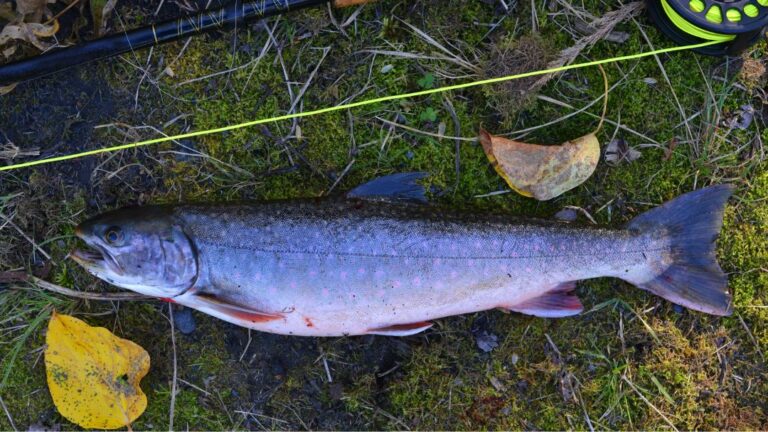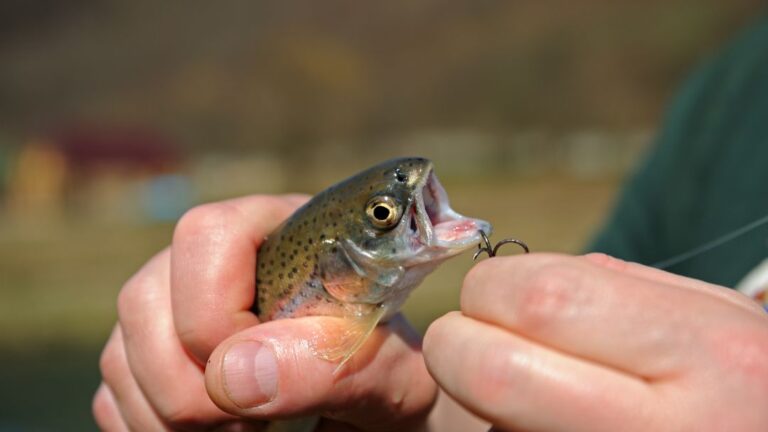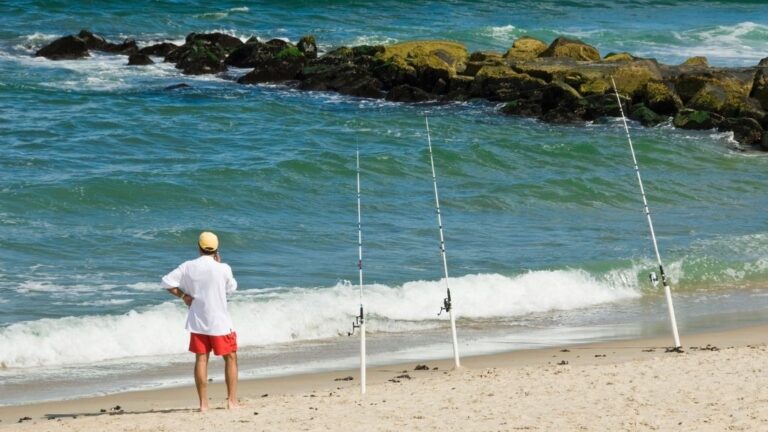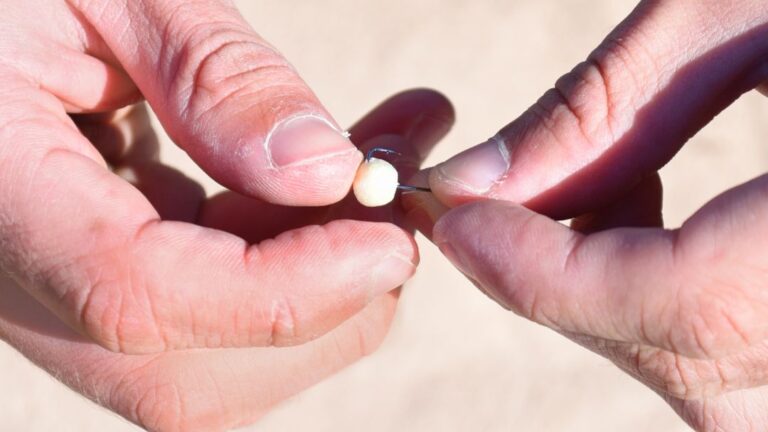Best Time To Fish For Trout In Summer
The best time to fish for trout in summer is during the early morning or late evening hours. Fishing for trout in the summertime can be a rewarding and enjoyable experience for anglers of all skill levels.
Trout are known for their agility and strength, making them a popular catch among fishing enthusiasts. However, knowing the best time to fish for trout in the summer can greatly increase your chances of success.
During the hotter months, trout tend to be more active in the cooler parts of the day, such as early morning or late evening.
This is when the water temperatures are lower, and the trout are more likely to be feeding near the surface. Understanding the habits and patterns of trout in the summer can help you plan your fishing trips effectively and increase your chances of landing a prized catch.
Understanding Trout Behavior In Summer
Trout fishing enthusiasts know that having a good understanding of trout behavior is crucial for a successful fishing trip. This applies to all seasons, including summer. In summer, trout behavior undergoes significant changes due to various factors such as temperature, water levels, and food availability.
Knowing how these factors influence trout behavior can greatly improve your chances of hooking that prized trout. So, let’s dive deeper into the importance of understanding trout behavior in summer and how it can enhance your fishing experience.
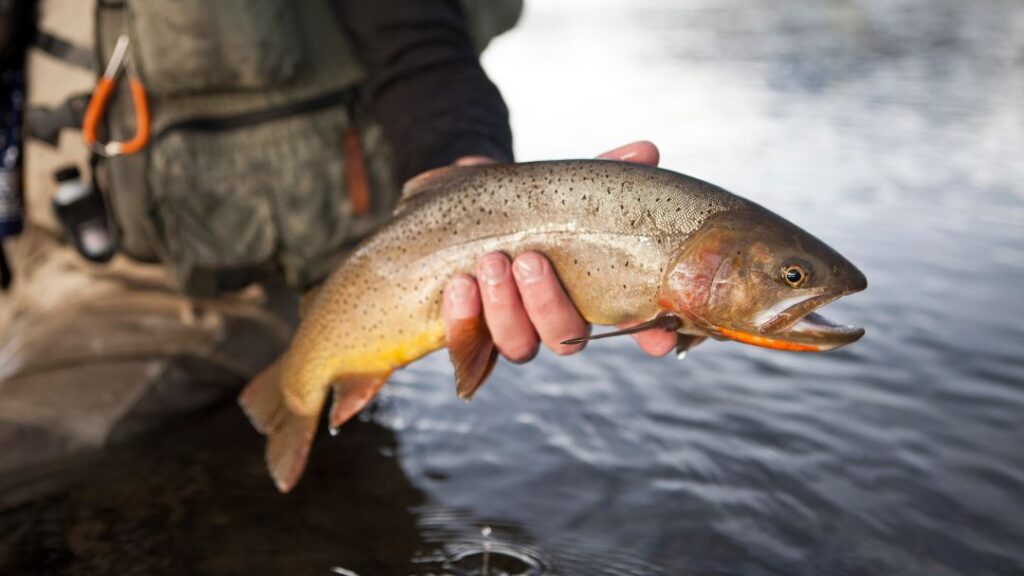
Factors Influencing Trout Behavior In Summer
In the summer months, several factors come into play that influence the behavior of trout. These include:
- Temperature: Trout are cold-water fish, and as temperatures rise during the summer, they seek out cooler habitats. Understanding the preferred temperature range of trout will help you locate them more effectively.
- Water Levels: Changes in water levels can impact trout behavior. In summer, water levels may decrease due to less rainfall, leading to reduced oxygen levels and altered feeding patterns. By monitoring water levels, you can determine the best fishing spots.
- Food Availability: As summer progresses, there is a shift in aquatic insect hatches, with different insects emerging at specific times. Knowing the prevalent food sources for trout will allow you to select the appropriate bait or fly patterns.
Understanding these factors and their effects on trout behavior in summer will give you a valuable advantage when it comes to finding and catching trout.
How Trout Behavior Changes During The Summer Months
As summer advances, trout behavior undergoes distinct changes. Here’s how:
- Feeding Habits: In the early summer, trout are often more active and willing to take surface flies due to increased insect activity. However, as water temperatures rise, trout become more selective in their feeding patterns, focusing on cooler, deeper water or near spring-fed tributaries.
- Shelter Preference: With the warmer temperatures, trout seek refuge in deeper pools, shaded areas, or under structures to avoid direct sunlight and cool down. Understanding their shelter preferences will help you target the right areas.
- Activity Patterns: During the hot summer months, trout tend to be less active during the midday heat. Fishing early mornings or late evenings when temperatures are cooler can increase your chances of catching actively feeding trout.
By adapting your fishing techniques and timing to account for these changes in trout behavior, you can optimize your chances of landing a prized trout even during the summer months.
Comprehending trout behavior in summer is paramount for successful fishing. By considering factors such as temperature, water levels, and food availability, you can adjust your fishing strategy accordingly and increase your chances of a productive outing.
So, get ready to make the most of your summer trout fishing adventures by understanding and capitalizing on their behavior patterns.
Morning: Prime Time For Trout Fishing
Morning is the ideal time for trout fishing in summer. Take advantage of this prime time to reel in the best catches and make the most of your fishing trip.
The Benefits Of Fishing For Trout In The Morning
- Abundant Trout: Morning is the prime time for trout fishing as these fish are more active and hungry during this time of day.
- Optimal Conditions: The cooler temperatures in the morning create ideal conditions for trout, making them more active and willing to bite.
- Less Competition: Many anglers prefer fishing in the afternoon, so by heading out early, you’ll have a better chance of finding a quiet fishing spot with fewer fellow fishermen around.
Ideal Water Conditions For Morning Trout Fishing
- Temperature: Trout prefers cooler water, so early morning temperatures are often ideal for finding them in shallow areas or near the surface.
- Oxygen Levels: In the morning, oxygen levels in the water are higher, providing a more comfortable habitat for trout.
- Low Light: The soft light of the morning creates less visibility in the water, making trout more confident and less wary of potential threats.
Tips For Successful Morning Trout Fishing
- Start Early: Be on the water at dawn or even before, as this is when trout are most active.
- Research: Prioritize locations that have shown success for morning trout fishing. Check local fishing reports, talk to fellow anglers, or seek advice from local fishing experts.
- Choose the Right Lures: Opt for lures that imitate the insects or baitfish trout feed on. Consider using light-colored lures during the early morning when visibility is low.
- Experiment with Depth: Trout are often found in different depths depending on the time of day and water temperature. Test different depths to find where the trout are biting.
- Be Patient and Stealthy: Practicing patience and moving quietly along the shoreline or in your boat can increase your chances of catching trout without spooking them.
- Stay Aware of Weather Conditions: Trout can be sensitive to changes in weather, so be conscious of how changes in temperature, wind, or cloud cover may impact their behavior.
So start your day early and make the most of the prime time for trout fishing in the morning. With their increased activity, optimal water conditions, and fewer competitors, you’ll have a better chance of hooking a trophy trout.
Remember to research your fishing spot, choose the right lures, and be patient and stealthy for a successful morning fishing excursion.
Evening: Another Great Time For Trout Fishing
Evenings in summer offer excellent opportunities for trout fishing, providing anglers with another great time to catch these prized fish.
The Advantages Of Fishing For Trout In The Evening
- Longer feeding periods: Trout are more active during the evening, as they tend to feed more frequently at dusk. This gives anglers a greater opportunity to catch them compared to other times of the day.
- Less fishing pressure: Evening fishing usually attracts fewer anglers, providing you with a more peaceful and serene experience on the water.
- Cooler temperatures: As the heat of the day starts to dissipate, the water temperature cools down in the evening. This can make trout more active and willing to bite.
- Beautiful scenery: Watching the sunset while casting your line is an added bonus of evening fishing. The beauty of nature during this time can enhance your overall fishing experience.
How Evening Conditions Differ From Morning Conditions
- Lighting: During the evening, the lighting conditions gradually dim as the sun sets. This can make it more challenging to see your surroundings, requiring you to adjust your fishing technique accordingly.
- Temperature: In the morning, the water temperature is typically lower compared to the evening. Trout may exhibit different behaviors and feeding patterns depending on the temperature.
- Insects: In the evening, you may encounter different types of insects compared to the morning. Understanding the insect activity can help you select the appropriate bait or flies for a successful fishing trip.
- Wind patterns: In some areas, wind patterns can become more prevalent in the evening. This can affect casting accuracy and presentation, requiring anglers to adapt their fishing strategies accordingly.
Techniques For Maximizing Your Catch During Evening Fishing Trips
- Choose the right bait or flies: Pay attention to the insect activity and adapt your bait or fly selection accordingly. Matching the hatch can greatly increase your chances of enticing trout to bite.
- Use stealthy approaches: As visibility decreases during the evening, trout become more sensitive to disturbances. Approach the fishing spot quietly, avoid sudden movements, and cast with precision.
- Focus on structure: Trout often seek shelter near structures such as rocks, logs, or submerged vegetation. Target these areas during your evening fishing trips, as trout may be more active and readily available.
- Experiment with retrieval speeds: Vary your retrieval speeds to mimic the natural movement of prey. Slow and steady retrieves can be effective, but don’t be afraid to try faster ones if the trout appear more aggressive.
- Stay patient: Evening fishing requires patience, as trout may take their time inspecting your bait or fly before striking. Avoid rushing or constantly changing your presentation, and allow the trout enough time to make a decision.
With the advantages of longer feeding periods, cooler temperatures, and lesser fishing pressure, the evening presents another excellent opportunity for trout fishing. Understanding how evening conditions differ from morning conditions and employing specific techniques can maximize your catch during these trips.
So, grab your fishing gear and head out for an unforgettable evening adventure on the water!
Fishing In The Heat Of The Day: Strategies And Considerations
The sun is blazing high in the sky, and the temperatures are soaring as summer takes hold. But don’t be discouraged from fishing for trout during the day! With the right strategies and considerations, you can still have a successful fishing experience even in the heat.
Here are some tips to help you adapt your approach and make the most of your angling adventures:
Why You Should Still Fish For Trout During The Day In Summer
Trout can still be caught during the day in summer if you make some adjustments to your fishing techniques. While trout may become less active in the heat, they can still be tempted by the right presentation and bait. Here’s why you should give it a shot:
- Opportunity for solitude: Many anglers prefer avoiding the early morning crowds or the evening rush, making the scorching heat of the day an ideal time to find a less-crowded fishing spot and have it all to yourself.
- Unique feeding patterns: Trout may adjust their feeding habits during the day to conserve energy in warmer water. Understanding these patterns can give you an advantage in targeting their preferences and improving your chances of success.
Adapting Your Approach To The Conditions
To increase your chances of hooking a trout during the day, it’s crucial to adapt your fishing approach to the prevailing conditions. Here’s how you can do so effectively:
- Fine-tune your presentation: During hot summer days, trout can be more selective with their food choices. Experimenting with different lures, baits, and techniques allows you to mimic the trout’s preferred prey and entice them to strike.
- Adjust your fishing depth: As the sun beats down, trout may retreat to deeper water where it’s cooler and more comfortable. Utilize weighted lines or sinkers to reach them in their preferred depths.
- Slow down your retrieve: Slowing down your retrieve speed can be effective for enticing trout during the day. The heat may make them sluggish and less likely to chase after fast-moving prey, so a slow and steady approach can yield better results.
Seeking Out Cooler Water And Shady Areas
When the sun is blazing, it’s essential to seek out cooler water and shady areas where the trout are more likely to take refuge. By focusing your efforts on these locations, you can greatly improve your chances of a successful catch.
Consider the following:
- Look for spring-fed streams or rivers: These water sources tend to be cooler, as they are fed by natural springs that maintain a more constant temperature throughout the year. Trout are more likely to congregate in these areas during the summer months.
- Target shaded spots: Overhanging trees, rock formations, and other natural structures that create shade can provide relief from the scorching sun. Trout often seek cover under these shady areas to escape the heat, so casting near these spots can be fruitful.
Remember, fishing for trout during the day in summer requires a bit of patience and adaptability. By adjusting your approach, targeting cooler water and shady areas, and understanding the unique feeding patterns of trout in the heat, you can still enjoy a successful day of angling even under the hot sun.
So, grab your gear, find your favorite fishing spot, and embrace the challenge of fishing for trout in the heat of the day!
Night Fishing For Trout: A Unique And Rewarding Experience
Experience the unique and rewarding adventure of night fishing for trout during the summer. Discover the best time to fish for trout while immersing yourself in the tranquility of the night, creating unforgettable memories on the water.
If you’re an avid angler, you may have never considered the thrill of fishing for trout at night. However, night fishing can offer a unique and rewarding experience for trout enthusiasts. The serene ambiance reduced fishing pressure, and an opportunity to catch elusive trout make it an adventure worth trying.
In this section, we will explore the benefits of fishing for trout at night, discuss best practices, and recommend gear and techniques for successful night fishing trips.
Exploring The Benefits Of Fishing For Trout At Night
Night fishing for trout comes with its own set of benefits that you won’t find during daytime fishing expeditions. Here are some advantages to consider:
- Reduced fishing pressure: With fewer anglers hitting the water at night, you’ll have less competition. This increases your chances of landing a prized trout without fighting for the best fishing spots.
- Elusive trout behavior: Many trout species tend to become more active during the night. They venture out into shallower areas and can be more susceptible to your lures or bait. Exploring their nocturnal behavior adds an intriguing element to your fishing adventures.
- Serene ambiance: Fishing under a starlit sky and enjoying the tranquility of nature can be a refreshing change from the hustle and bustle of daytime fishing. The peacefulness of the surroundings creates a surreal experience.
Best Practices For Night Fishing
To make the most of your night fishing for trout, it’s crucial to follow some best practices. Consider these tips to enhance your chances of success:
- Research the fishing spot: Prior knowledge of the fishing spot will give you an advantage. Look for areas where trout are known to be active during the night. Research local blogs, and forums, or connect with experienced anglers for valuable insights.
- Use a stealthy approach: Trout have heightened senses, especially in low-light conditions. Approach the water silently, avoiding any disturbances that may spook the fish. Use headlamps with a red filter to maintain your night vision while setting up your gear.
- Optimal moon phase: Pay attention to the moon phase as it can affect trout feeding patterns. The best nights for fishing are often during a new moon or when the moon is at its lowest visibility. These darker nights provide better cover for trout.
- Experiment with different lures: Trout have specific preferences for different lures based on their feeding behavior. Experiment with a variety of lures such as spinnerbaits, soft plastics, or night crawlers to find what entices them best in the dark.
Recommended Gear And Techniques For Successful Night Fishing Trips
Equipping yourself with the right gear and mastering the techniques suited for night fishing can significantly improve your chances of success. Here are some recommendations:
- Quality headlamp: Invest in a high-quality headlamp that provides adequate lighting while allowing you to keep your hands free for casting and handling fish.
- Lighted bobbers: Attach lighted bobbers to your line, enabling you to easily track your bait’s movement and detect subtle trout bites in the darkness.
- Fluorescent fishing line: Opt for fluorescent fishing line to improve visibility and sensitivity during the night. This helps you detect even the slightest nibble on your line.
- Slow presentation: Trout can be more cautious and deliberate at night. Slow down your retrieve or drifting speed to give them ample time to strike your bait.
- Patience and persistence: Night fishing for trout requires patience and persistence. Don’t give up if you don’t get immediate results. Keep adapting your techniques and exploring different areas until you find the sweet spot.
Night fishing for trout is an adventure that introduces you to a whole new world of angling. The calmness of the surroundings, the chance to catch elusive trout, and the thrill of fishing under the moonlight make it an experience worth embracing.
Follow these best practices, ensure you have the right gear, and be prepared for an unforgettable night on the water.
Seasonal Variations: Adjusting Your Tactics Throughout The Summer
Discover the best time to fish for trout in the summer with our helpful tips for adjusting your tactics to seasonal variations. Gain an advantage and optimize your fishing experience during this warm and sunny season.
How Trout Behavior Changes As Summer Progresses:
- In the early part of summer, trout tend to be more active, feeding on insects and other small prey. The longer days and warmer water temperatures provide optimal conditions for their activity.
- As summer progresses and water temperatures rise, trout become less active during the day and seek refuge in cooler, deeper areas of the water. They may also feed more selectively, targeting larger prey to conserve energy.
- During the hottest part of the summer, trout become even more sluggish and tend to feed in the early morning or late evening when temperatures are cooler. They may also move to areas with more oxygen-rich water, such as riffles or springs.
- Understanding how trout behavior changes throughout the summer is crucial for adjusting your fishing tactics. By adapting to their behavior patterns, you can improve your chances of success on the water.
Strategies For Targeting Different Trout Species Based On The Season:
Rainbow Trout:
- In the early summer, rainbow trout are more active and can be found near the surface, especially in rivers and streams. They are opportunistic feeders, targeting insects, baitfish, and other small prey.
- As the summer progresses and water temperatures rise, rainbow trout may move to deeper pools and seek colder water. Target these areas using sinking lines and weighted flies or lures.
- During the hottest part of the summer, focus on fishing early in the morning or late in the evening when rainbow trout are more active. Look for shaded areas or tributaries where cooler water flows into the main body of water.
Brown Trout:
- Brown trout are known for their wariness and can be more challenging to catch during the summer. In the early morning and late evening, they may actively feed on the surface, making dry fly fishing a productive technique.
- As summer progresses, brown trout become more selective in their feeding habits. Use nymphs or small streamers to imitate their preferred prey, such as crayfish or small baitfish.
- During hot summer days, brown trout seek refuge in deeper pools, undercuts, or near submerged structures. Target these areas using weighted flies or lures and fish slowly to entice a strike.
Brook Trout:
- Brook trout are highly adaptive and can be found in a variety of water types, from small streams to larger rivers and lakes. In the early summer, they are more active and can be caught using dry flies or small nymphs.
- As summer progresses, brook trout seek cooler, oxygen-rich water. Look for them in tributaries, spring-fed streams, or areas with ample shade. Use lightweight gear and stealthy techniques to approach them without spooking.
- During the hottest part of the summer, brook trout may become more cautious and selective in their feeding. Match their preferred prey, such as terrestrial insects or small minnows, to increase your chances of success.
Adapting To Water Temperature And Conditions To Optimize Your Success:
Water Temperature:
- Trout are cold-water species and have specific temperature preferences. In the early summer, when water temperatures are cooler, trout can be found in shallow areas and near the surface.
- As summer progresses and water temperatures rise, trout seek cooler water and move to deeper pools or areas with increased oxygen levels. Adjust your fishing depth accordingly to target them effectively.
- Use a thermometer to monitor water temperature and focus on fishing during the optimal temperature range for trout species in your area.
Water Conditions:
- In the early summer, trout may be more active and willing to chase lures or flies in slightly faster-moving water. Look for riffles or runs where water is aerated and oxygen-rich.
- As summer progresses and water levels decrease, trout become more cautious and seek slower-moving water where they can conserve energy. Focus on fishing in pools, eddies, or near structures that offer cover.
- Pay attention to weather conditions and how they affect water clarity. Trout may be more skittish in clear water, requiring stealthier fishing techniques and natural-looking presentations.
Time of Day:
- During the early summer, trout can be more active throughout the day. Take advantage of the longer daylight hours and try fishing during various times to determine when they are most actively feeding.
- As summer progresses and water temperatures rise, trout tend to be more active during low-light periods, such as early morning or late evening. Adjust your fishing schedule accordingly for higher chances of success.
- Pay attention to insect hatches or other natural food sources that trout feed on. Fishing during peak feeding times can greatly increase your chances of enticing a strike.
By understanding how trout behavior changes throughout the summer, targeting different trout species based on the season, and adapting your fishing tactics to water temperature and conditions, you can optimize your success when fishing for trout in the summer months.
Remember to always follow local fishing regulations and practice catch-and-release to help preserve trout populations for future generations.
Fishing Regulations And Licensing Requirements
Discover the best time to fish for trout in the summer while adhering to fishing regulations and licensing requirements. Stay in compliance and maximize your chances of a successful catch by knowing the perfect moments to cast your line.
The Importance Of Knowing And Adhering To Fishing Regulations:
Anglers must be aware of and comply with fishing regulations, especially when it comes to trout fishing in the summer. Understanding these rules not only helps preserve the trout population but also ensures a sustainable and enjoyable fishing experience for everyone.
Here are some key points about the importance of knowing and adhering to fishing regulations:
- Conservation of trout population: Fishing regulations are in place to protect the trout population and maintain a healthy ecosystem. These rules help prevent overfishing, preserve breeding habitats, and support the natural equilibrium of the fish populations. By adhering to these regulations, you contribute to the preservation of trout for future generations.
- Compliance with legal requirements: Fishing regulations are legal requirements that must be followed by all anglers. Failure to comply with these rules can result in fines, penalties, or even the revocation of fishing privileges. By understanding and abiding by fishing regulations, you not only avoid legal troubles but also show respect for the environment and fellow anglers.
- Ensuring fair and equal opportunity: Fishing regulations help create a level playing field for all anglers. They establish limits on bag and size limits, specify fishing methods, and designate catch-and-release areas. Adhering to these rules promotes fair and sustainable fishing practices, ensuring that everyone has an equal opportunity to enjoy the sport.
Licensing And Permits Needed For Trout Fishing In Summer:
Before casting your line for trout in the summer, it’s important to have the necessary licenses and permits. Here’s what you need to know:
- Fishing license: In most regions, a valid fishing license is required to fish for trout. This license is generally available for purchase online or at authorized retailers. The fees for fishing licenses vary depending on factors such as residency status, duration, and age. Make sure to obtain the appropriate license and carry it with you while fishing.
- Trout stamp or additional permits: Some areas may require an additional trout stamp or special permits specifically for trout fishing. These additional documents help fund conservation efforts and enhance trout management programs. Check with local fishing authorities to determine if you need any additional permits beyond the standard fishing license.
- Age and residency requirements: Fishing licenses may have age restrictions, with exemptions for seniors and children under a certain age. Residency requirements may also apply to fishing licenses, with different fees for residents and non-residents. Always verify the specific licensing requirements for your location and demographic.
Resources For Staying Informed About Local Fishing Regulations:
Staying informed about local fishing regulations is essential to ensure compliance and a successful fishing trip. Here are some resources you can utilize:
- Government fishing websites: Most government bodies responsible for managing fish and wildlife resources have dedicated websites that provide comprehensive and up-to-date information on fishing regulations. These websites often include details about fishing seasons, size limits, bag limits, and special regulations for specific water bodies. Bookmark these sites and refer to them regularly for any changes or updates.
- Fishing guidebooks and brochures: Many regions produce fishing guidebooks and brochures that outline local fishing regulations and provide valuable tips and advice. These resources are often available at sporting goods stores, and visitor centers, or can be downloaded from official websites. Carry a copy of the guidebook or brochure with you while fishing to ensure you have the most accurate regulations on hand.
- Local fishing communities: Engaging with local fishing communities, whether online or in-person, can provide valuable insights into the latest fishing regulations. Join fishing forums, connect with local fishing clubs or associations, and participate in discussions to stay updated on any changes in regulations or local fishing insights. Experienced anglers can offer tips and recommendations based on their firsthand experiences.
- Fishing apps and online platforms: In today’s digital age, there are numerous fishing apps and online platforms that offer information on local fishing regulations. These tools provide convenient access to fishing regulations, license purchasing options, interactive maps, and even real-time updates on fishing conditions. Explore these resources and find the ones that best suit your needs and preferences.
Remember, fishing regulations can vary by location, season, and species. Always stay informed about the specific regulations in your area and take necessary precautions to ensure the well-being of the trout population and the sustainability of the sport you love.
Conclusion
Summer is a fantastic time for trout fishing, but timing is key to maximizing your chances of success. By focusing on early mornings and late evenings, when the water is cooler and trout are more active, you can increase your odds of landing a prized catch.
Pay attention to weather patterns and plan your fishing trips accordingly, as overcast days can provide excellent conditions. Using light and natural-colored tackle, along with matching your bait to the trout’s natural food sources, will also improve your chances. Don’t forget to be patient and observant, as trout can be cautious and easily spooked.
As with any type of fishing, persistence, and experimentation are key to refining your techniques and becoming a successful trout angler. So grab your gear, hit the water, and enjoy the thrill of trout fishing during the summer months.

